Blocked bladder in male cats
[ad name=”Tweet”]
Cats can be prone to getting recurring bladder problems which makes them urinate in unusual places instead of in their usual tray or outside. Cats will urinate in the bath or basin, on the bed, on laundry or on the bathmat, for example. The inflamed bladder lining leads to a hypersensitive bladder which makes the cats urinate even when there are only a few drops of urine in the bladder. These bladder problems often recur frequently, and since cat urine has a particularity nasty odor, owners can often get very frustrated with their cats. Some cats are even put to sleep for this very reason. This article deals with the most common causes of bladder trouble in cats and how best to deal with them. A blocked bladder in male cats due to bladder stones is a life threatening emergency.
BLOCKED BLADDER in male cats
Bladder stones and consequently blocked bladders in male cats are a veterinary emergency. Blocked bladders in male cats happen when tiny bladder stones pass out the bladder down into the urethra inside the penis. The stones lodge there inside the urethra in the penis and can end up blocking the urethra fully, so that the cat cannot pass urine at all, or only a few drops at a time.
Over time the bladder gets fuller and fuller and may even rupture inside the cat’s abdomen. This is a VETERINARY EMERGENCY as cats can die from this. If you suspect your cat has a blocked bladder, do not leave it, even for a few hours. As the urine builds up inside the bladder it has nowhere else to go so it goes back up into the kidneys and fills the up as well, effectively stopping urine production. Dangerously high levels of potassium can build up in the bloodstream which at first slow and then finally stop the heart. If the bladder bursts inside the cat’s abdomen, the body then absorbs all the poisons from 24 hours of urine production at the same time into the bloodstream which poisons the cat, leading to extremely high potassium levels which can stop the heart.
WHAT CAUSES BLADDER STONES
A blocked bladder in male cats is a result of a blockage. A blockage can be caused by either a stone or a plug of protein type material together with small crystals and junk. The end result is the same.
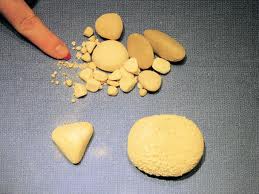
- DIET – some diets are rich in minerals which tend to precipitate out in strong urine, forming crystals and then bladder stones
- INFECTION – a bladder infection may make the urine more ‘sticky’ which provides a perfect opportunity for small crystals to stick together, forming stones.
- METABOLIC – some animals have a defect in their metabolism, causing bladder stones, but this is more common in dogs than cats.
Signs and history of a blocked bladder in a Tomcat
- Cat stands in box for ages straining to urinate
- Cat appears to be constipated
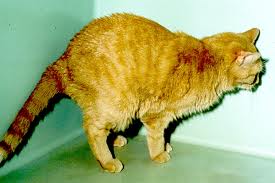
- Small drops of bloody urine on penis tip or in sand
- Sand is dry, despite cat spending a lot of time in its box
- Cat makes weird vocal noises – low pitched and crying
- Cat tries to wee in pot-plants, on the couch, in the basin and the bath and on the bathmat or owner’s clothes.
- Cat is comatose or not moving
- Cat cries when picked up due to the pressure on the full bladder
- Cat’s tummy seems to be bloated or full
- Rock hard mass in abdomen
- Male cats, usually 3 years plus, slightly tubby
- It is the change of season.
- Cats are usually castrated males
Treatment of a Blocked Bladder in male cats
This is an emergency. Once your vet has diagnosed a blocked bladder, your cat will be admitted to hospital and will stay there approximately three days. Your vet will put your cat under deep sedation or general anaesthetic and will pass a small bore catheter up the urethra (the tube through which urine runs in the middle of the penis.)
Your vet may be able to push the plug or stone back into the bladder with the catheter, or may have to flush saline or lactated ringers up into the catheter where it has lodged in the penis behind the blockage. In many cases the stone or plug is either stuck just as the urethra narrows as it leaves the bladder and goes into the penis or right at the tip of the penis. Sometimes plugs or stones can be massaged out as well.Once the blockage (stone or plug has been cleared the urine can pass through the catheter and out the body. The catheter is usually sutured to the skin and left in for at least 24 hours to allow small stones and plugs and other debris to pass out the bladder safely.
If the catheter is removed to early, the cat may block up again and if the catheter is left in too long (more than 48-72 hours ) it predisposes the cat to getting a bladder infection.
EMERGENCY TREATMENT FOR SERIOUS CASES
- Your cat may be put onto a drip to help flush the toxins out of the body. If your cat is severely ill or comatose, it may be too dangerous to give him an anaesthetic due to the high potassium levels in the bloodstream which affect the heart, and your vet may decide to drain the bladder with a needle first and pass a catheter 24 hours later, once the kidney function is closer to normal. This also holds risks for the cat as the distended bladder may also rupture with a needle prick, releasing the toxic urine into the abdomen, putting further strain on the heart and kidneys. Your vet will decide on the best plan of action for your dangerously ill cat at this point, but both routes pose a risk, unfortunately.
-
TREATING ONCE THE EMERGENCY HAS PASSED
Once the emergency has passed, your vet will check and analyze the urine for sediment (red and white blood cells, crystals, bacteria and protein casts), pH, macroscopic and microscopic blood, white blood cells, ketones, bilirubin, glucose and protein.
- Your cat will often be started on antibiotics as many stones that form in the bladder are as a result of a bladder infection and the strain the bladder underwent will also make it more vulnerable to infection. Urinary acidifiers used to be used in the past, but are no longer recommended. Your cat may also be given painkillers, and it is recommended that your cat’s kidney function be assessed with a blood test. I usually prefer to do this the following day up to three days later, as directly after a blockage, the kidney enzymes will always be high as the kidney was blocked as well. Your vet may also prescribe glycosaminoglycans such as ‘cystaid’ for the bladder lining to help repair it.
TREATING WITH THE CORRECT DIET
- An important part of preventing this from happening again is putting the cat onto the correct diet. Many good pet food manufacturers will make a prescription diet specifically for bladder stones – normal pet food won’t work. When these pets are put onto the special diets, they must have nothing else, not even milk or a bit of tuna on the food or you will be wasting your money. These diets keep the pH of the urine correct which helps to prevent as well as dissolve small stones, as well as providing very few minerals in the diet other than the essential ones, so that crystals cannot form. This is the final treatment or last step in treating these after everything else as these cats can get urinary tract infections more easily afterward and also require care in some cases (hair clipping) of the region for the rest of their lives. Examples include the Hills c/d diet, s/d diet, Royal Canin Urinary and Eukanuba Struvite diets.
-
URETHROSTOMY
In rare cases, when there is a lot of scarring, your cat may get recurring episodes of blocked bladders and may need surgery – known as a urethrostomy in which the penis is removed and the opening for the urine is enlarged so that stones can pass out without causing a problem. This used to be the first line of treatment for these cats, but with advances in diet and treatment, a urethrostomy is only done as when there is , for example, so much scarring inside the urethra that a cat keeps on getting blocked up. Post op, these cats can be prone to developing bladder infections as well as needing care of the op site, such as hair trimming, sometimes for the rest of their lives.

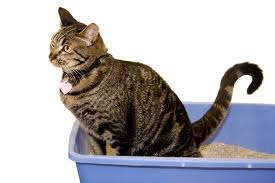

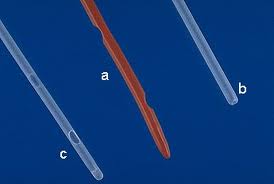
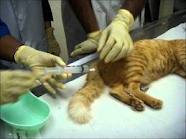
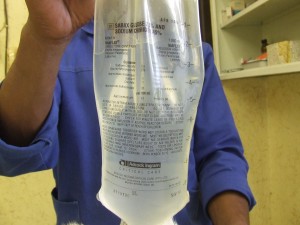
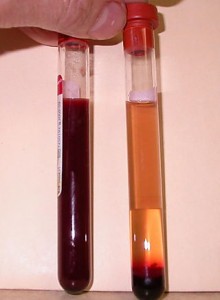
Leave a Reply
You must be logged in to post a comment.